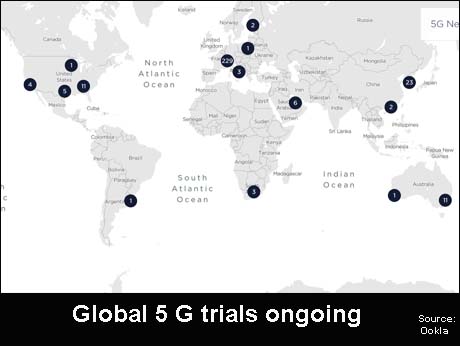
Read IndiaTechOnline OPINION at the end of this report.
Inspite of launching a series of 5G test beds 2 years ago, India does not have a single limited or trial deployment as of today... in a competitive world where 300+ locations are already up and working in some measure.
New Delhi, May 15, 2019: Ookla, the company behind Speedtest, has unveiled a first-of-its-kind Ookla 5G Map, an interactive resource which tracks 5G rollout in cities across the globe.
Currently, no limited or commercial deployments have been identified in India.
Users can get more detailed information including city name, a list of operators who have rolled out 5G, and the status of the 5G network in the area by clicking on an individual pin that appears on the Ookla 5G Map.
The status on the map is divided into two types of availability: limited and commercial. Limited availability is when a 5G network is present but devices are limited to select users. Commercial availability refers to a 5G network where any consumer can purchase a device for use on this network.
As the world paves the way for 5G technologies with roll out in city after city, it becomes important for the industries and consumers to track network deployment and operator status for 5G across the globe. Ookla updates the 5G map weekly with the information available about 5G deployments as and when they occur.
Ookla has identified 303 5G deployments around the world at the time of launch, provided by 20 operators in 294 cities. Switzerland leads as the country with the most current 5G deployments in 217 cities, each with commercial availability.
INDIATECHONLINE COMMENT: 'Twixt word and deed
India began formal preparation for the rollout of 5G in tandem with many advanced economies -- amost 3 years ahead of scheduled launch. A High Level forum for 5G India 2020 was formed in September 2017, chaired by the Secretary, Communications, with Secretary Electronics& IT and Secretary Science & Technology as co- chairpersons and some 20 other members including directors of key IITs , MDs of the largest private sector telecom providers, Reliance Jio, Bharti Airtel -- and with Dr A Paulraj, PIO and emeritus professor of EE at Stanford University (US) and inventor of MIMO -- a crucial technology that underpins all wireless communication -- as a key member and effectively the tech leader of India's 5G programme.
A year later came the first formal document spelling out an ambitious plan to leverage 5G for national and citizen development: Making India 5G Ready-Report of the 5G High Level Forum.
There is a saying: 'The job isn't over till the paperwork is done', a phrase that read in a naughty way, makes it a favourite bathroom graffiti. In India the job often begins and ends with only paperwork accomplished. The distinguished (as its name self-asserts) "High Level" committee and the drespected names it carried, led one to hope that real work would follow, if not precede the paper work. Multiple 5G test beds were setup in educational institutions like IIT Delhi, IIT Madras, IIIT Hyderabad.
In 2018, Swedish telecom leader Ericsson set up a Centre of Excellence & Incubation Centre with a 5G test bed at IIT Delhi and just one year later, on May 8, The Economic Times reported that the Swedish company had announced it was suspending trials on the test bed. Why? Because the Indian government having provided the necessary spectrum for free, was now asking Ericsson to pay for it. Pay for spectrum to conduct trials of 5G at an educational institution, after the telecom company had provided the equipment and borne most of the system costs? Bizarre as it sounds, that is the demand that was made and which led to Ericsson saying ' ta ta' after virtually sponsoring the trials for 24 months.
India's Department of Telecommunications is the agency to allocate spectrum ( by its own choosing, in short spells of 3 months), for all 5G test beds and trials being conducted by educational institutions as well as bilaterally by service providers like BSNL, Bharti Airtel, Vodafone with networking majors like Nokia, Ericsson and Huawei, Most of these tests demand continuous trials for a year or more to stabilise the system , iron out kinks, work for backward compatibility with 4G.... before commercial rollout can happen.
DoT is already under severe criticism for its short sighted and cash-centric policy of milking maximum revenue for 5G spectrum, leading almost all Indian service providers to show a singular lack of enthusiasm for the next round of spectrum auctions. Now it seems, it is extending its trademark avarice even to the testing phase of India's 5G programme -- when most nations virtually subsidise their national players' trials to ensure a place at the global high table of 5G.
That is why inspite of all those multiple test beds at multiple IITs and the high minded aims mouthed at apex bodies like the High Level 5G Forum, the reality of the Ookla map of global 5G rollouts, suggests that the Indian subcontinent is one big Black Hole, without a single --even an experimental -- 5G network running, just a year away for the planned commercial rollout . You can have the world's top tech talent working with you -- and India's 5G programme has it in the person of Paulraj.
But all that matters little, as long one arm of the same government department, injures its other arm and in the process, shackles critical technology efforts with foolish financial demands.
Disconnected words and deeds? Indeed! Anand Parthasarathy